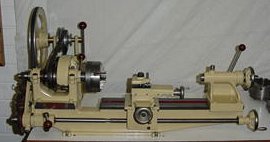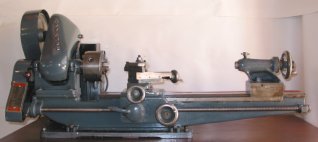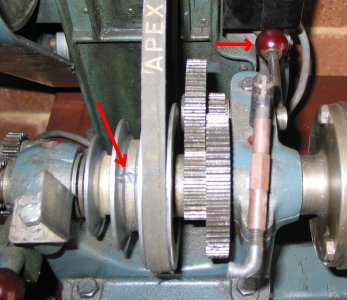



This page is to provide general information about the Advance metalworking lathe, an example of which I own. If you can add, correct or confirm any information on this page, please contact me. Copies of any documentation such as manuals or sales literature would be greatly appreciated as a number of us are looking for this material. If you'd like to have pictures of your Advance lathe added to the page, send them along. Even if you have nothing new to add, I'd still like to hear from you if you have one of these lathes.
Disclaimer: The author has provided these pages as a means of sharing his hobbies and experiences with others. The author is not an expert on any of the material presented, and the information may be inaccurate in places. Some of the machines or techniques shown may not meet current safety standards. There are inherit safety issues with most of the subject matter and these issues are not dealt with here. Use of any information presented herein is at your own risk and the author assumes no responsibility for personal injury, property damage or financial losses resulting from the use of said information.
About the Advance
The Advance is an Australian made bench top lathe, the design of which is based on the popular British made Myford ML2/ML4. Like the ML2 and ML4, the Advance was shipped with many variations over its lifetime. Further, manufacturing changed hands at some point, adding to the changes. Some of the variations include:
Beyond that, it seems Alfred Stewart changed their business structure around a bit. My lathe is badged "Alfred Stewart Pty. Ltd. Melbourne, Aust. Sole Agents for Advance Machine Tools Pty. Ltd." while another owner's is badged "Alfred Stewart Manufacturing Engineers Pty. Ltd Kilsyth Victoria".
It is worth noting that there is another ML4 clone, the British made "Perfecto".
I should mention the lathes.co.uk web site. It contains information on a great many lathes and considerable lathe documentation is available for purchase. There is significant information as well as literature available for both the Myford ML2/ML4 and the Perfecto, but sadly, no literature for the Advance as yet. I have no experience with the Myford or Perfecto manuals sold there so can't say how useful the information may be for the Advance lathe. Links are at the bottom of the page.
Peoples Lathes
Go on, make my day and send me a picture of your Advance so I can put it here.
Click the images below for full details on each of the lathes.

AK287. Tony's early Advance. Very nice.
Tony is also rebuilding a round bed Drummond. He's after the following parts: cast iron tray (short round bed), flywheel, treadle and pitman. The treadle may be same as that used on the B/M type Drummonds. He has for exchange, if necessary, a long round bed tray, countershaft (also suit B/M type), set of M type legs, free standing foot motor (treadle) and a set of M type change gears (less 73 tooth gear). Alternatively he may be interested in purchasing a B/M type. Tony can be contacted at Tony.x.Watson at dva.gov.au (replace "at" with "@" to complete the email address).
Using Accessories From Other Lathes
Head stock spindle nose. On lathes with a plain bearing head stock, the spindle nose thread is a 1", 10 tpi Whitworth (55 degree) form. A little searching on the Internet indicates a 1" x 10 tpi thread was used on a few other metal lathes and it is a common thread for woodworking lathes. My old Woodfast woodworking lathe has this thread and some woodworking face plates I have fit the Advance. I'm told the thread does not match any standard tap.
On lathes with a roller bearing head stock, the thread is 1 1/4" x 10 tpi. I have no idea if anything else uses this.
Neither thread is the same as that used on the late model Myford ML2/ML4's (or the 7 series Myfords) or the Perfecto. A useful resource is "Machining and fitting a chuck back plate" at the The Model Engineer Support Page.
Head stock and Tail stock tapers. It appears that the head stock taper on all versions is MT2. On early lathes, the tail stock taper is MT1, on later lathes MT2.
Change Gears. Presumably the Advance, ML2/ML4 and Perfecto all use identical gears. However gears for those machines aren't readily available. Fortunately Myford ML7 gears are readily available and can be adapted quite easily to the ML2/ML4 (and presumably the Advance). See the lathes.co.uk ML2/ML4 page for more information on this.
Parts
With the manufacturer long gone, I don't expect any original manufacturer parts are still around. No doubt many parts for the Myfords or Perfecto would fit this lathe. Unfortunately Myford no longer have any parts for the ML2/ML4, nor have I been able to locate a source for Perfecto parts.
Here's what I know of that you can get:
Enabling the Back Gear
If its not obvious to you how to do this, welcome to the club. Another Advance owner was kind enough to put me on the right track.

Switching in and out of back gear should be done with the lathe stopped.
To engage, locate the grub screw on the spindle pulley and loosen off. Ensure the pulley spins freely on the spindle. If not, see "Servicing the Head stock Spindle and Bearings" below. Swing the indicated handle towards the front of the lathe to engage the gears. You may have to wiggle the spindle or chuck a little to get the gears to engage properly.
To disengage, swing the indicated handle back until it points backwards from the lathe. Don't swing it as far as it will go, it will only re-engage the gears. Slowly tighten down the pulley grub screw, rotating the pulley as you go to locate the small hole the screw locks into. Note that the grub screw for the gear on the end of the spindle lines up with the hole for the pulley grub screw. Once you have located the hole, rock the pulley back and forward as you slowly tighten so the grub screw seeks out the lowest point (the hole in my lathe was worn into an oval shape, deeper in the middle).
Setting up the Change Gears for Screw Cutting
On the left is a picture of the change gear settings chart should anyone need it. Click the image for a larger version you can actually read.
Some imperial and metric threading tables for the standard gear set are available here. For additional discussion on change gears and the program I wrote to create those tables, see the ChangeGears download below.
Servicing, Modifications and Repairs
General Cleaning, Lubrication and Setup
- I was going to put up a nice page on this with pictures, but there is
plenty of suitable info on other web pages. For example at mini-lathe.com
or The Model
Engineer Support Page.
Servicing the Head stock Spindle and Bearings
- Click for plain bearings or tapered
roller bearings.
Hints and Tips
From Tony Watson: "The proper oil for slide ways and head stock bearings is the same as chain bar oil sold for your chain saw. This is a 'sticky' oil and makes a world of difference to the machine's feel - silky smooth! I got this advice from the Shell technical help line after they said when it is branded as Tellus slide way lubricant it is only available in 20 and 200 litre drums. Chain bar oil is available in 500ml bottles."
Downloads
ChangeGears - A simple application I wrote to figure out best-fit change gear settings for any imperial or metric thread. Follow the link for threading tables and other information on change gears.
Links
lathes.co.uk-
Lots of specific lathe information including Advance
(based on information from this site), Myford
ML2/ML4 info, Perfecto
info and Manuals.
The
Model Engineer Support Page - Great site. The Workshop section has
lots of info pertaining to small lathes.
mini-lathe.com
- 7x10 / 7x12 Asian mini-lathe site with plenty of useful info.